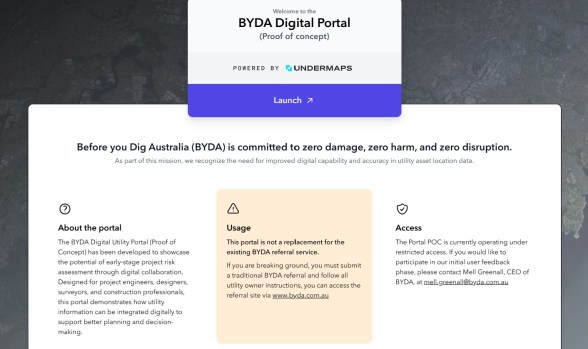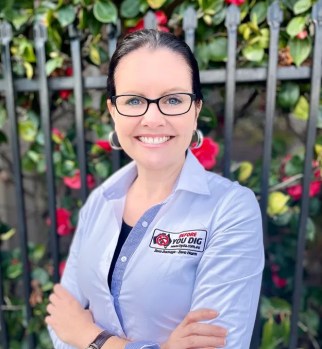Across Australia, local governments are grappling with an increasingly complex set of challenges — meeting ambitious housing targets, coordinating infrastructure delivery, modernising aging networks, whilst building resilience in the face of climate and economic uncertainty.
Underpinning all of these priorities is a growing need to understand what lies beneath our cities.
Underground utilities — gas, water, telecommunications, electricity and more — form the invisible foundation of every community. Yet the way we access, manage and visualise this critical data has not kept pace with the demands of modern infrastructure delivery. This gap creates unnecessary risk, delays, and cost.
To help solve this problem, Before You Dig Australia (BYDA) has launched a Digital Portal proof of concept (POC) — a transformative geospatial platform that enables real-time, map-based access to underground utility data. Developed in partnership with leading utilities and powered by Reveals Undermaps technology, the portal is designed to support safer, smarter, and faster decision-making for planners, project managers and engineers
Local government has a pivotal role to play in this innovation — and a great deal to gain.
A national challenge that starts locally
The Australian Government has made housing supply and infrastructure delivery national priorities. States and territories are implementing housing accords, fast-tracking planning approvals, and setting density targets that will rely heavily on local government to deliver enabling infrastructure.
But accelerating development without first understanding subsurface constraints is a proven recipe for conflict. Too often, essential works are delayed or redesigned due to clashes with poorly mapped underground assets.
At the same time, local councils continue to face the operational and reputational consequences of third-party damage to their own infrastructure — from ruptured water mains to service outages and public safety risks.
The economic cost is staggering. BYDA’s recent economic research estimates that avoidable damage to underground assets imposes a $5 billion annual cost on the national economy through direct repair bills, project delays, lost productivity and service disruption.
The solution is not just about more data — it’s about better data, delivered smarter. That’s where the BYDA Digital Portal comes in.
Advancing GIS for public good
The Portal builds on the foundation of BYDA’s national referral service, which processes over 16 million asset enquiries annually. But unlike the current PDF-based response model, the digital platform allows users to view, interact with and analyse utility information within a unified, map-based GIS interface.

Built leveraging Reveals Undermaps technology, the platform supports a future-ready geospatial ecosystem where digital utility data can be visualised in real-time, spatially analysed, and integrated with digital twins, planning overlays and asset management systems.
This is not just a modernisation — it is a fundamental shift in how the built and buried environment is understood and managed.
There are five strategic reasons councils should engage now — both as data providers and end-users.
1. De-risk housing and infrastructure acceleration
Whether planning new housing precincts, major roads, or precinct-scale upgrades, early access to utility data enables faster approvals, fewer design revisions and improved collaboration with service providers. For high-growth councils, this is an essential tool for delivering infrastructure in lockstep with housing supply.
2. Modernise asset management and reduce operational risk
Councils manage vast underground networks — stormwater, water, sewerage, lighting and comms infrastructure. By contributing this data to a national platform, councils can protect their own assets from damage and support safer operations for field crews and contractors.
3. Enhance safety and compliance
Third-party damage remains a leading cause of safety incidents on civil works sites. Providing clearer, more accessible utility data directly reduces the likelihood of unintentional strikes, thereby protecting workers, residents and essential services.
4. Support smart cities and digital transformation
Participation in the portal aligns with broader council strategies around smart cities, open data and digital service delivery. It creates a shared geospatial foundation for integration with other platforms — asset registers, emergency management systems and infrastructure digital twins.

5. Demonstrate leadership and collaboration
Forward-thinking councils have an opportunity to help shape national data infrastructure. By joining the portal early, they can help inform design standards, governance, and integration pathways that reflect local needs.
What BYDA is asking of councils
We are seeking expressions of interest from councils willing to:
- Share digital GIS records for underground infrastructure under their control;
- Explore user testing and integration with existing systems and workflows.
BYDA provides full onboarding support, data security protocols aligned with ISO 27001, and flexible contribution models based on council capability. As a not-for-profit industry body, our mandate is to facilitate access, and drive damage prevention and support Australia be a world leader in utility management.
Building infrastructure above ground starts with clarity below
The scale of Australia’s infrastructure and housing task cannot be understated. To meet it, all levels of government must collaborate in smarter, more integrated ways. Local government stands at the heart of this challenge — and holds the key to unlocking meaningful change.
By joining the BYDA Digital Portal development, councils are not just improving local operations — they’re helping to build the geospatial backbone of a safer, more productive nation.
It’s time to move beyond PDFs to manage utility safety.
For more information on BYDA’s Digital Portal project, contact Mell Greenall, CEO of Before You Dig Australia (BYDA), via mell.greenall@byda.com.au or 0407 166 706.




Leave a Reply